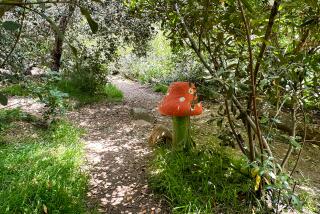In a chokehold

Southern California’s environment is fast approaching the tipping point as an onslaught of foreign plants overwhelms efforts to protect the region’s natural landscape.
In Los Angeles County, authorities warn that nonnative plants, including pampas grass, arundo and yellow star thistle, have largely displaced many native species. More than 300 invaders have colonized the Santa Monica Mountains alone, says Christy Brigham, restoration ecologist for the Santa Monica Mountains National Recreation Area.
Since state funds dedicated solely for weed eradication dried up two years ago, the county Agricultural Commissioner’s office has received $13,000 in grants from Sacramento in an attempt to continue with the abatement efforts, but the amount is less than half of what is needed to remove by hand one acre of arundo, a giant stream-choking plant. Other agencies also contract with county personnel to do eradication work.
Steve Schoenig, president of the California Invasive Plant Council, which tracks nonnative species statewide, estimates the cost to eradicate the region’s worst plant pests at $20 million a year for a decade. Getting rid of all the invaders, he says, would cost nearly $1 billion. Private and federal funds provide $2 million to $4 million annually for control on public lands.
Despite some success — Orange County has beaten back pesky coastal algae — victories are few, and L.A. County officials say they are concentrating on containment of alien species rather than eradication. Yet, even that effort flags.
“We have a number of sites under suppression, but there are a lot of areas like Big Tujunga Canyon, Little Tujunga Canyon and places on the Westside where nothing is being done at all,” says Jim Hartman, who heads the anti-invasive species program for the Agricultural Commissioner’s office.
Across Southern California, nonnative plants drain streams, add fuel for wildfires, replace wildflowers, drive out songbirds and ruin coastal sand dunes. Unchecked, scientists say people can expect fewer deer, birds and rabbits and less trout in streams as biologically diverse ecosystems give way to ho-hum weedscapes.
“Beautiful little wildflowers that we love — that make the spring such a great time here — will be gone. They can’t compete with these mega-monster weeds,” Brigham says.
Californians brought exotic plants here for yard decorations, freeway windbreaks and as food for people and livestock. Exotic species comprise nearly one-fifth of the plants in the state today. Among the most troublesome: Algerian ivy. The fast-growing ornamental with big leaves easily surmounts barriers. “Go up Santa Anita Canyon out of Chantry Flats and toward Hogie’s Flat, you’ve got Algerian ivy that runs right up the watercourse. It’s so dense in there that it just suppresses everything else and it’s growing up into the trees. It’s a biologic disaster,” Hartman says.
Salt cedar and perennial pepperweed. Their roots concentrate salt in soil, killing other plants. Pepperweed occurs near Gorman and Malibu Creek while salt cedar is widespread in washes.
Yellow star thistle. A rancher’s nightmare, the weed overtakes pasture, robs livestock of food and is extremely difficult to remove. It infests about 22 million acres in California and causes $60 million in water and grazing losses, experts say. Once it colonizes slopes, its shallow roots don’t keep soil stable, making canyons vulnerable to mudslides.
Geraldton carnation spurge. This tall European weed with tiny yellow flowers and sticky white sap has “spread like crazy” on the Malibu Bluff at the expense of native forage for deer, rabbits and insects, Brigham says.
The sheer fecundity of these plants often outraces bureaucracy. The Copper fire near Santa Clarita in 2002 burned arundo to the nub in San Francisquito Canyon, but in the two months it took to secure permits to remove it, Hartman says, the plant had grown back and was more than 4 feet high, doubling removal costs.
The invaders spread incrementally, and by the time authorities notice trouble, it’s often too late to stop it.
“Invasive weeds aren’t seen as the problem that they truly are,” Hartman says. “A lot of these species are insidious. They creep slowly in places and you don’t know how bad they are until all of a sudden they are everywhere. Then you notice that the wildlife isn’t here.”






